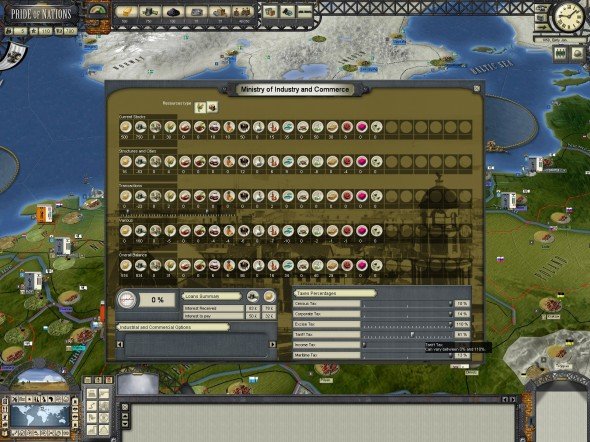Pride of Nations Preview

We're shown the commerce screen; there are six different taxes you can tweak. Every menu we're shown is filled with numbers and icons.
It also simulates your population, telling you whether your people are happy or miserable, and whether they like your policies. We're next shown the construction screen, where you can build iron or coal mines, mineral or nitrate quarries, gold or gems fields. This is just under one submenu. You can also build other industry buildings, military buildings, railroads or ports.
To help create conflict, the game has an engine for dynamically generating crises. Events will happen around the world that force a dramatic confrontation between countries: say, for example, an American boat explodes near Cuba. The countries involved, and their allies, are pitted into a negotiation mini-game that works like poker. Everyone puts their stakes on the table, and tries to pressure their opponents into doing what they want. If it doesn't work, war could break out.
In other words, the rules stop you from creating war at will, but if you can manipulate circumstances well enough, you can generate war at the point when you want it to happen.
If two large countries with lots of allies go to war, it could begin a Great War. If that happens, the game's victory conditions change: you don't just need a lot of prestige, but a victorious power of that war. This is designed to stop players quitting halfway through because they've decided they will win no matter what. Like the real world did after World War 1, the world can change dramatically and very suddenly.
To help people hop into the game, there are specific Battle Scenarios you can play. If you just want to play the Russian/Japanese war, you can select a scenario where the map is limited down to just those regions of the world effected. But the main game doesn't start slow and then grow from there. If you choose a country like Britain, you already have a huge empire to manage. They are amongst the hardest country to control. On the other hand, it can be slightly easier if you start with a country like Australia, which have a smaller territory to manage.

Each country has its own style. If you choose Russia, the country is basically a giant farm with nothing but peasants, and it can take a long time to build an industry. But you also have the largest army in the world, meaning few people will try to attack you.
The biggest gaming news, reviews and hardware deals
Keep up to date with the most important stories and the best deals, as picked by the PC Gamer team.
The countries you don't control also have their own objective. When the game begins, America exists only as the East Coast. The AI knows they need to conquer the west coast, unite the country, and attempt to prevent civil war. The idea is that each individual action and area of the game's simulation is simple to control and understand, but that when all these elements are combined, you gain an appreciation for how complicated it is to run a country. "You are not God," explains Philippe. "You are Prime Minister."
At this point we're shown a screen that gives you details of your country, covering Research, Religion, Education, Trade, Economy, Nationalism, Government, Army, Bureaucracy, Society, Power Projection and Organisation. Just looking at the stats is giving me a nosebleed.
Oh god, Philippe just turned on the weather overlay, showing how hot or cold it is in each area. This influences the military model, where your soldiers if not properly equipped could find themselves dying in the snow.
All of this detail is an obvious concern when it comes to making a game accessible, but I'm quickly realising while looking at the games here that it doesnt mater. Not everthing has to be accesible, and the amount of detail in Pride of Nations is staggering. In terms of scale, this is as impressive as any open world in something like Grand Theft Auto IV. It just doesn't look as good.

